Willful Blindness: How Denial Left Texas Children Defenseless Against the Climate Crisis
From systematic climate erasure to 'thoughts and prayers,’ the deadly cost of choosing not to see.
In our latest 'Chatting the Pictures' video, we examine the aftermath at Camp Mystic—where the dining hall's ripped-open wall stands in stark contrast to the now-placid Guadalupe River that killed 27 children. How does classic camp imagery transform into evidence of institutional failure? And what does a rescue boat reveal about the broader patterns of systemic breakdown in protecting children from climate disasters?
Watch now.
The Great Erasure
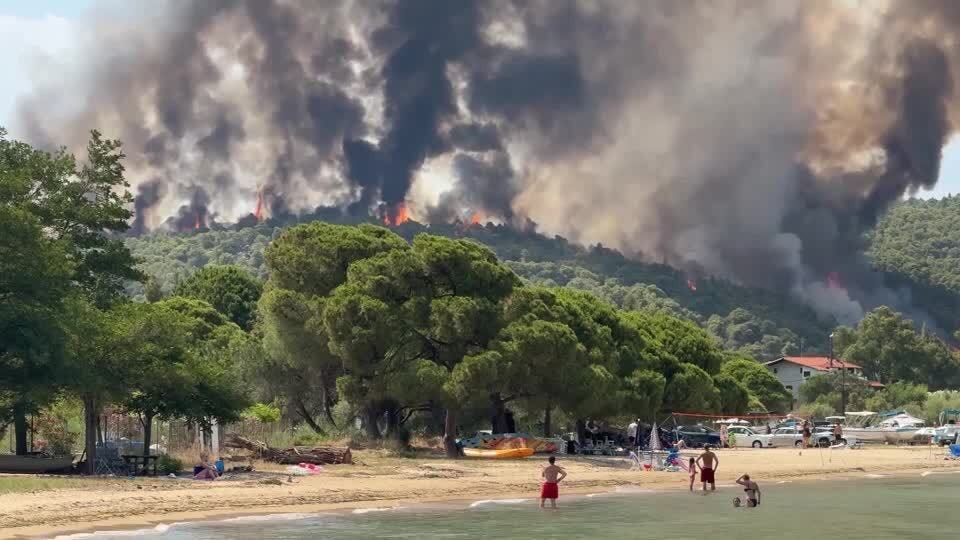
Climate disasters are multiplying, intensifying, and breaking records. What's vanishing is our ability to see them as evidence. This photo of tourists in Greece watching flames engulf the nearby hills is a metaphor for our age.
Half a year into Trump's second term, the administration has perfected strategic blindness—systematically dismantling the historic climate measures Biden put in place while disappearing our tools to track its rampant acceleration. Federal climate websites scrubbed clean. NOAA gutted. EPA programs eliminated. FEMA is threatened with extinction. This chosen ignorance all but guarantees that we'll blow past the key climate tipping points, making containment impossible.
The Disasters You Haven't Seen
Was the deluge in the Texas Hill Country a one-off disaster?
Before Kerr County made headlines this summer, 2025 had already delivered a relentless barrage of catastrophic flooding across the United States. In February, a historic torrent swept through Kentucky, West Virginia, Tennessee, and Virginia, killing 18 and causing over $2 billion in damages—the deadliest and costliest flood in the region's history. May saw atmospheric rivers inundate the Mid-Atlantic, pushing the Potomac River to its highest stage in decades.
What follows is a sample of recent climate catastrophes that have received little coverage despite their scale. These are just the latest in an escalating series that includes last fall's Hurricane Helene and Milton one-two punch, January's LA firestorms, and this summer's return of Canadian wildfire smoke choking U.S. cities. People don’t hide these disasters—they systematically ignore them and treat them as freak events rather than as evidence of an alarming pattern.
City Drowns
A city of 300,000 people, half-submerged in Guizhou province. Climate change has made extreme rainfall the new normal.
Mass Casualty Graduation
More than 150 people fell ill from extreme heat at a New Jersey graduation, with nine hospitalized. Celebrating milestones in the summer in more and more places now requires emergency medical response.
800 Years, Gone
The Swiss village of Glatten, which had existed for eight centuries, was destroyed when a glacier collapse released nine million tons of rock. The climate crisis isn't just threatening the future—it's erasing the past.
Canada's Annual Crucible
Smoke from dozens of Canadian wildfires blankets multiple U.S. states. The "wildfire season" now lasts year-round, but receives coverage only when American cities are shrouded in a blanket of particulates.
Texas: "Nobody Saw This Coming"
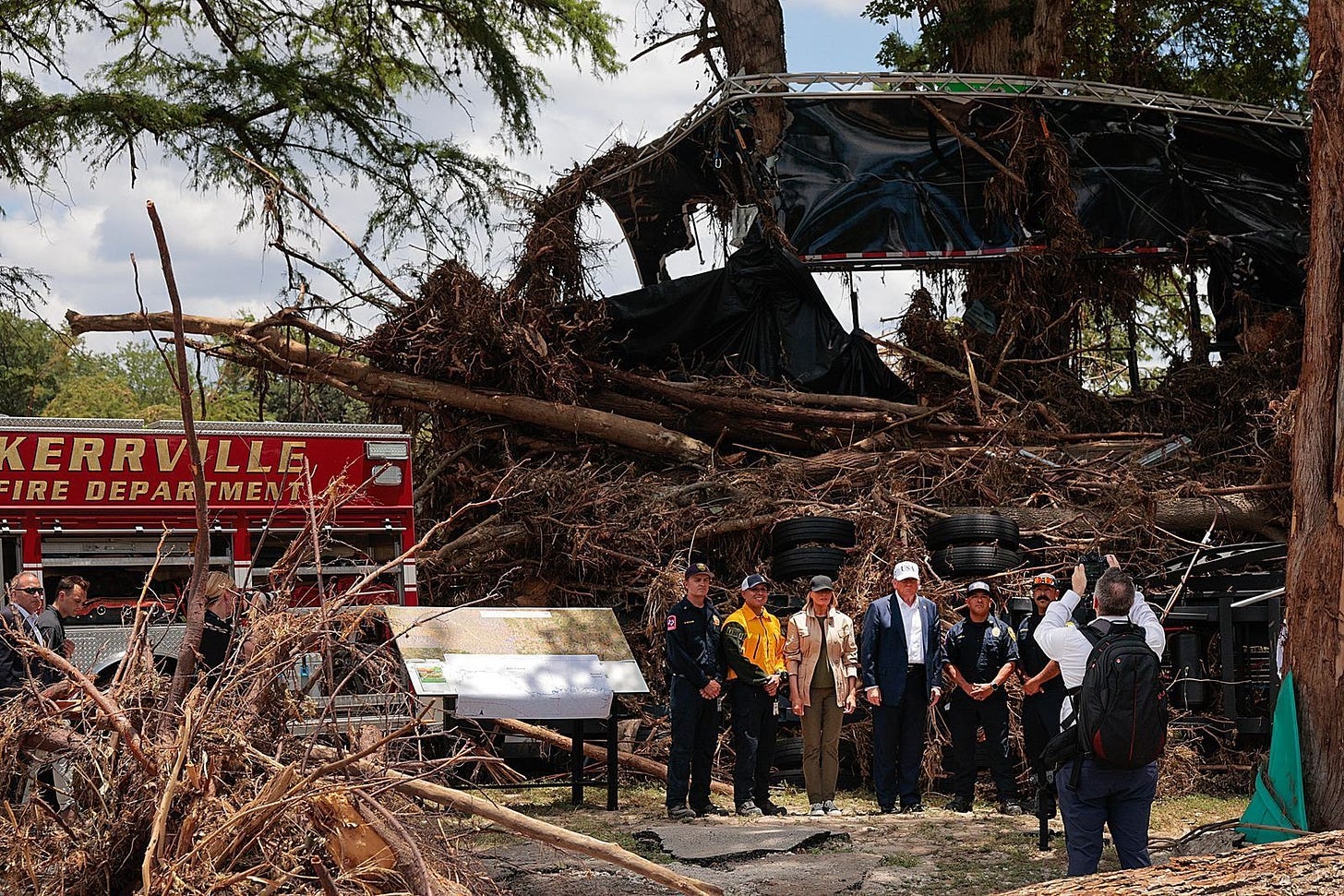
The image perfectly captures the scene for what it is—the photo of a photo op. The play to the cameras, and Trump’s physical diminution in the photo, is a biting commentary on "showing up."
As 1.8 trillion gallons of water—four months' worth of rainfall supercharged by climate change—fell in hours, Camp Mystic, a century-old Christian institution hosting the daughters of Texas political elites, became a death trap. The flood killed twenty-seven children and counselors, while rescuers evacuated the surviving campers as they sang hymns.
Officials deflected blame onto the very emergency agencies Trump had gutted. The White House accused critics of spreading "falsehoods" about warning systems. At the same time, Texas leaders insisted "nobody saw this coming"—despite climate scientists warning for years that intensifying rainfall would make flash floods deadlier.
Faith, Flags, and Blinders
Nowhere is the dismissal of global heating more apparent than in Trump country, where escalating disasters are viewed as acts of God rather than predictable consequences.
The Irony of Loyalty

A Trump campaign sign clings stubbornly to a flood-ravaged home during Hurricane Helene. Even as political loyalty endures the storm, the policies it represents all but guarantee that future disasters will be even more severe.
Praying Away the Crisis
This Kerr County prayer circle, formed in the aftermath of the Texas floods, reveals the conflation of faith and nationalism. In communities where devotion to God and country merge into one, divine providence is seen as the explanation for the devastation, while federal agencies become suspect as enemies.
Martyrdom vs. Real Victim
A car hood painted with Trump's assassination attempt photo sits in flood-devastated Kerr County like a shrine to manufactured martyrdom. While Trump turned it into campaign gold, his followers live with the real consequences of his reality distortion. The "PRAYER" arrow directing citizens to a service for the victims completes the irony.
The Cost of Looking Away
A search-and-rescue volunteer found this Camp Mystic T-shirt along the Guadalupe River. "I hope I find the person to return their belongings, not to find closure," he told a reporter. That hope captures what we've lost to strategic ignorance: the chance to prevent rather than merely recover.
The children of Texas drowned not because the climate crisis was invisible, but because whole political and industrial systems depend on not seeing it. When willful blindness becomes policy, recovery replaces prevention, prayers substitute for preparation, and children become collateral damage in the war on reality.
Chatting the Pictures is a podcast for pictures. In these 3-4 minute videos, we closely examine essential news photos complemented by related imagery. The videos feature writer and photo historian Cara Finnegan and psychologist and Reading the Pictures publisher Michael Shaw. Liliana Michelena produces CTP. You can see the archive on our legacy website and recent examples on our Instagram feed.
Chatting the Pictures is a feature of Reading the Pictures. Despite our visually saturated culture, we remain among the few sources for analyzing news photography and media images. To receive new posts and support our work, consider becoming a free or paid subscriber.



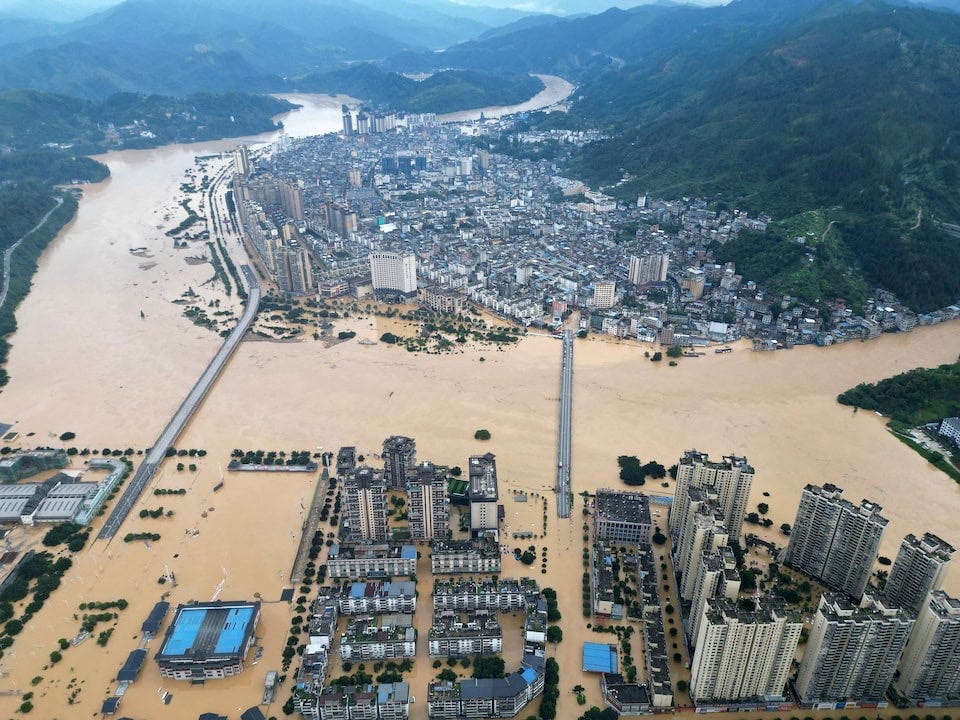


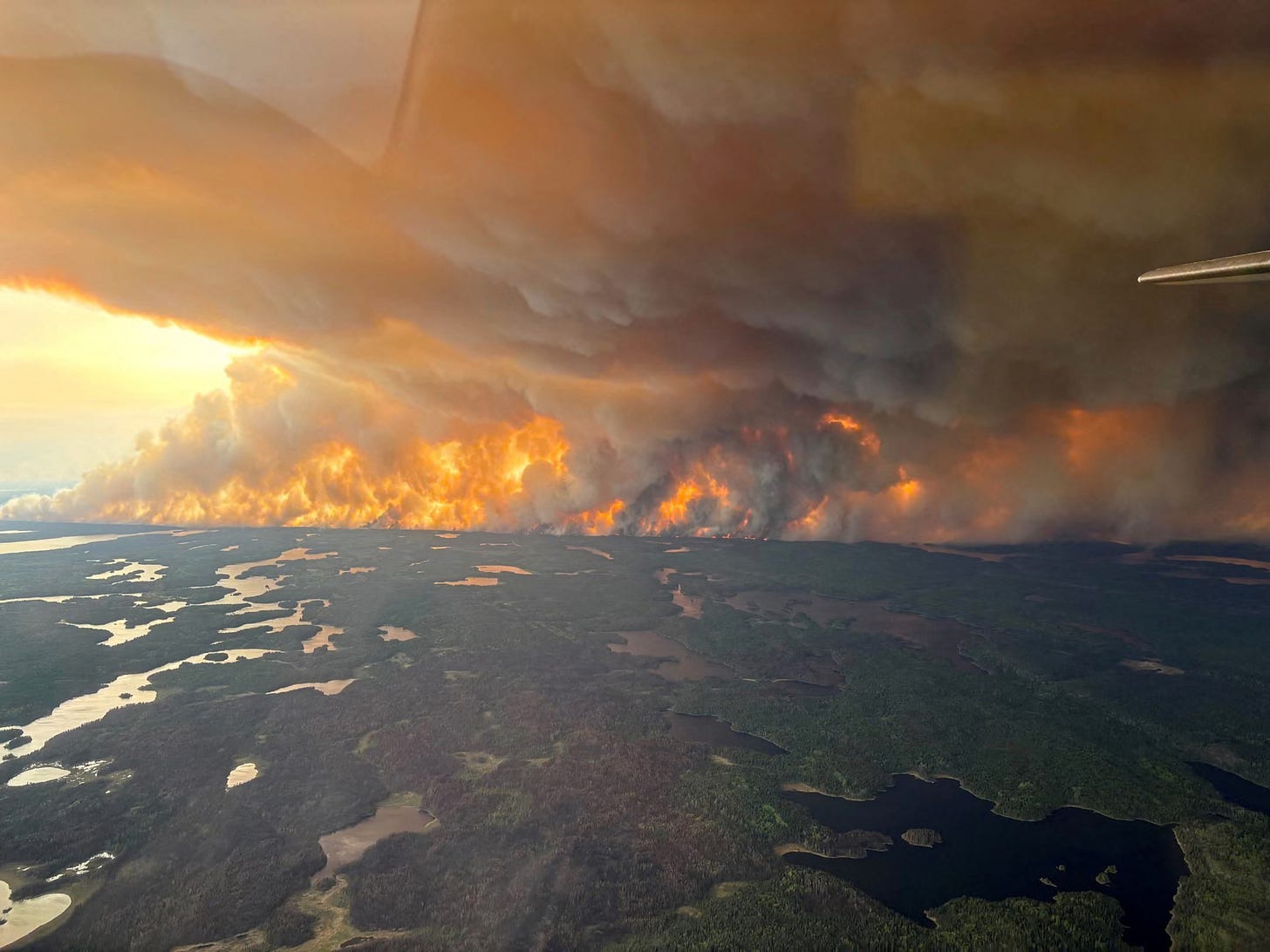

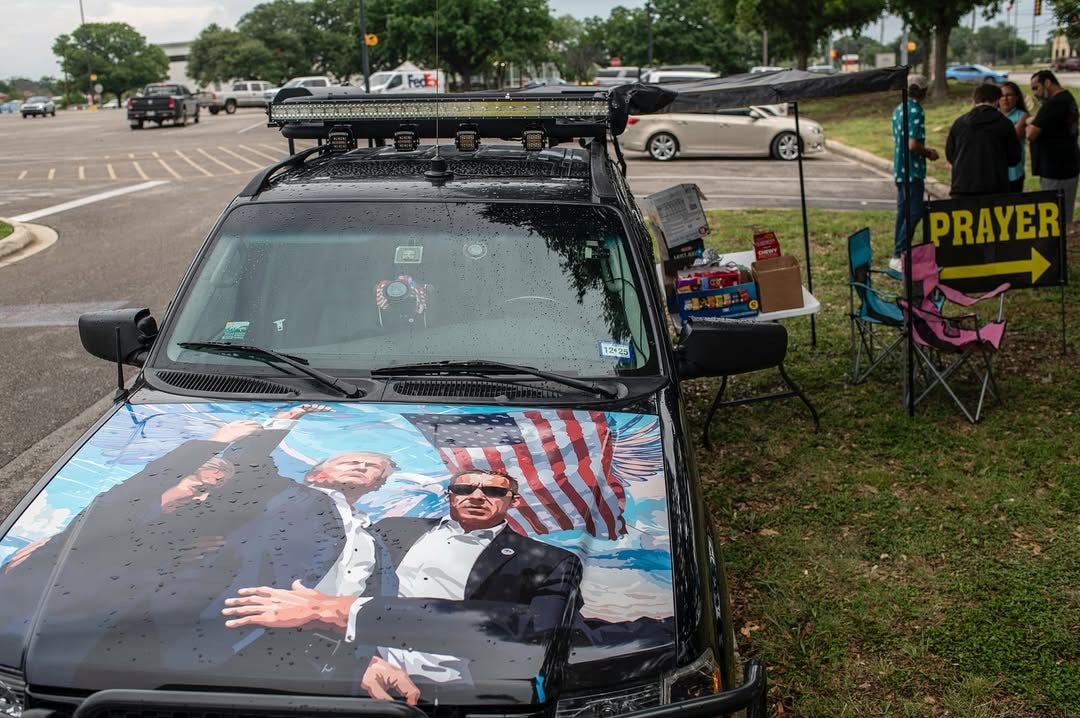
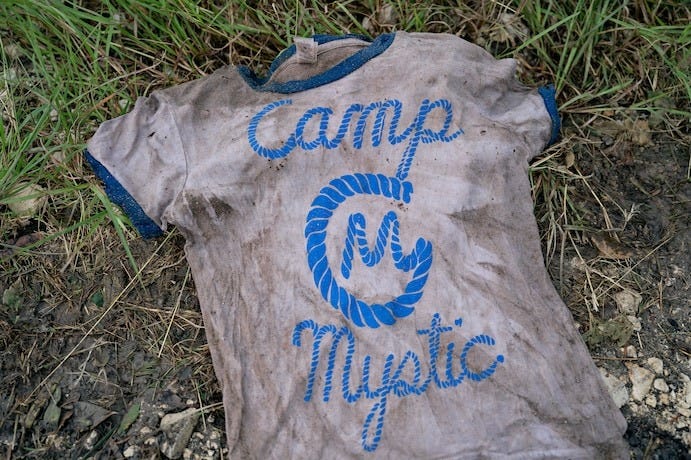
J.M. Mikkalsson wrote: I find it ironic that Chris Hedges wrote in American Fascists, in 2006, that "the popular Christian textbook America's Providential History cites Genesis which calls for mankind to have dominion over the fish of the sea and over the birds of the air and over the cattle and over all the earth and over every creeping thing that creeps upon the earth." The book teaches students that "Christians primary responsibility is to create material wealth. God will oversee the increase and protection of natural resources. America's Providential History belittles secular environmentalists who see natural resources as fragile and limited and says of those who hold these concerns that they 'lack faith in God's Providence and consequently men will find fewer natural resources... the Christian knows that the potential in God is unlimited and that there is no shortage of resources in God's earth.'
These are the people supporting that there is no shortage of resources in God's earth!'
These are the people supporting Project 2025. And yet, hardly anyone says outloud that this is the vision now driving our Nation's policies and laws.
The Canadian wildfires are doubly erased—I'm noting the handout photo you used. Unfortunately it's a practice that's become commonplace in Canada where the combination of an under-resourced media with the normalization of excluding journalists means we rarely see first hand the impacts of such disasters.